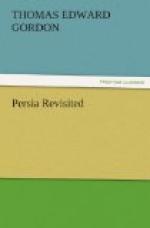[Transcriber’s note 1: The original text has Durnfsh-i-Kawah. The original Farsi is Derafsh-i-Kaviani. The typesetter must have read an ‘a’ as an ‘n’. Durnfsh is otherwise unpronounceable.]
CHAPTER VI.
—The Order of the Lion and the Sun —Rex and Dido —Dervishes —Endurance of Persian horses —The Shah’s stables —The sanctuary of the stable —Long distance races —A country of horses —The gymkhana in Tehran —Olive industry near Resht —Return journey —Grosnoje oil-field —Russian railway travelling —Improved communication with Tehran.
The distinguished Persian Order of the Lion and the Sun was instituted by Fateh Ali Shah, in honour of Sir John Malcolm, on his second mission to the Court of Persia in 1810, in company with Pottinger, Christie, Macdonald-Kinneir, Monteith, and other British officers, who rendered excellent service to Persia in organizing a body of her troops. These officers were followed by others, who in 1834, under Sir Henry Lyndsay Bethune, led the troops they had trained against the Pretenders who, on the death of Fateh Ali Shah, opposed the succession of the Vali Ahd (heir-apparent), Mohamed Shah, father of the late Sovereign. The Pretenders were defeated by Sir Lyndsay Bethune, and thus England established the stability of the throne of the Kajars in the direct line, and carried out the will of the great Fateh Ali Shah, who had appointed his grandson to succeed him after the death of his son, Abbas Mirza. During all the changes since Mohamed Shah’s accession, Persia has always had reason to regard England as a friendly neighbour who has no aggressive designs against her. This feeling must have become conviction on finding that the defeat she suffered in 1856 caused her no loss of territory in the South, and the Order of the Lion and the Sun continues to be a signal sign of strong friendship between the two nations.
There are two great St. Bernard dogs belonging to the British Minister at Tehran, which, by their leonine appearance and tawny red colour, massive forms and large limbs, have made a remarkable impression on the imaginative Persian mind. They are dogs of long pedigree, being son and daughter of two famous class champions. Never being tied up, but allowed full freedom, they are perfectly quiet and good-natured, though at first sight, to the nervous, they may look doubtful, if not dangerous. These powerful giant dogs accompany the Minister’s wife in her walks, and seem to know that they are to guard and protect; showy, gay Rex precedes, with his head up and eyes all about, while Dido follows, with head down, lioness-like, watchful and suspicious. Painful experience has taught the street-scavenger curs, which dash savagely at strange dogs, to slink away at the sight of this pair of champions, and the passers-by, who, as Mohammedans, are merciless to dogs, treat them as quite different from the dog they despise, so that they walk along feared and respected by all, man and dog alike. A Persian gentleman, riding past with his mounted followers, drew up at the sight of these St. Bernards, and said, ’I would give the finest Kerman shawl, or the very best Persian horse, for a puppy dog of that breed.’




